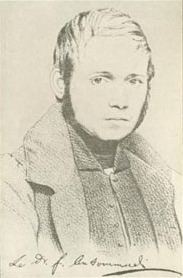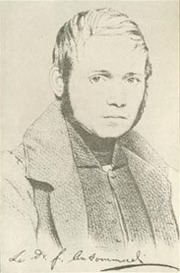Spouse(s) Never married Parents Francesco Antommarchi | Name Francois Antommarchi Children None | |
 | ||
Books Napoleon - The First Emperor, The Last Days of Napoleon, The Last Days of the Emperor, The last days of Napoleon | ||
Dr François Carlo Antommarchi (5 July 1780 in Morsiglia, Corsica – 4 March 1838 in Santiago de Cuba, Cuba) was Napoleon's physician from 1818 to his death in 1821.
Contents
- Dissertation on cataract 1808
- Napoleons Death Mask 1821
- Diary of Napoleons Medical Care
- Anatomical Prints of the Human Body with Natural Dimensions Paris 1823
- Name variants
- Birth
- Napoleons death mask
- Right Hand Cast of Napoleon
- Mascagni Heirs
- References

He began his studies in Livorno, Italy, and later earned the degree of Doctor of Philosophy and Medicine at the University of Pisa in March 1808. Antommarchi then went to Florence, Italy, and was attached to the Hospital of Santa Maria Nuova. Antommarchi earned the diploma of Surgeon in 1812 from the University of Florence (i.e. Imperial University) and was appointed by its president as Prosector. While in this capacity, Antommarchi worked under Paolo Mascagni (1752–1815) starting on 7 July 1813.
Antommarchi left Florence for Saint Helena to become Napoleon I's physician until his death. Antommarchi took up this position at the behest of Napoleon's mother Maria Letizia Ramolino and his uncle Cardinal Joseph Fesch. Antommarchi received a letter of employment on 19 December 1818. Antommarchi was sent to St. Helena in replacement of Dr Barry Edward O'Meara as Napoleon's personal physician, because the illustrious captive would not agree to accept medical officers such as Dr Alexander Baxter or Dr James Roch Verling, who were proposed to him by his custodian, or "gaoler", sir Hudson Lowe. However, Napoleon was not so impressed by Antommarchi's medical skills and even dismissed him from his service a couple of times, only to let him resume his duty soon after. In the last moments of illness, Antommarchi was assisted by Dr Archibald Arnott, who was accepted by Napoleon at the pressing demands from his two officers, Count Montholon and Grand-Marshal Bertrand. After Napoleon's death, Antommarchi wrote The Last Moments of Napoleon where he concluded that Napoleon died of stomach cancer.
In 1831 Antommarchi went to Poland and became the general inspector of Polish hospitals during November Uprising where he assisted the Polish people in an uprising against the Russians. He fled to Paris to escape the czar's forces.
Antommarchi then immigrated to Louisiana where he donated the bronze death mask of Napoleon to the people of New Orleans in 1834. Antommarchi lived in Veracruz, Mexico, for a brief period, and was employed there as an itinerant physician. He moved from Mexico and settled in Santiago de Cuba, Cuba, where he again worked as a physician. The move to Cuba was prompted by Antommarchi seeking his cousin Antonio Juan Benjamin Antommarchi, who made his fortune in coffee plantations. Antommarchi became adept at performing surgery for the removal of cataracts. He died in Cuba, of yellow fever, on 3 April 1838, at the age of 57.
Dissertation on cataract, 1808
This work is mentioned in The Memorial of Saint Helena by Emmanuel, comte de Las Cases.
Napoleon's Death Mask, 1821
On 7 May 1821 Antommarchi took a plaster cast of Napoleon's face. Numerous copies of this cast have been made and some can be seen at these locations:
Diary of Napoleon's Medical Care
Antommarchi's diary contained detail records of his medical care for Napoleon. This diary is a source for numerous books published between 1823 and 1826. These books have been published in many languages including French, English, German, Italian, and Spanish.
Anatomical Prints of the Human Body with Natural Dimensions, Paris, 1823
Paolo Mascagni (1752–1815) was the most celebrated anatomist of his day. Antommarchi became Prosector to Mascagni who left manuscripts and drawings for an intended publication of a comprehensive complete anatomy with life-size figures. Antommarchi prepared the publication but was meanwhile called to Saint Helena. Antommarchi left, taking with him three copies of Mascagni's plates. When Antommarchi returned, he published these plates, printed from lithographs, under his own name in a monumental work which appeared from 1823 to 1826 under the title of: "Planches anatomiques du corps humain exécutées d'après les dimensions naturelles accompagnées d'un texte explicatif". The plates for the publication were drawn and possibly engraved by Antoine Seratoni.
Name variants
François Carlo Antommarchi's original name has many variants in the literature due to translations and misspellings:
The phonetic pronunciation of "François" is "frahn-swah".
Birth
The literature cites both 1780 and 1789 as the birth date of Antommarchi.
Napoleon's death mask
It is unclear if the original cast for the death mask of Napoleon made by Antommarchi survived. It is said that Antommarchi's cast failed but Dr Francis Burton apparently took another cast which survived. To complicate matters, Madame Bertrand, apparently related to Henri Gatien Bertrand and Napoleon's attendant, is said to have stolen a large part of the cast taken by Burton and given it to Antommarchi.
No unequivocal and decisive proof has ever been presented to settle this controversy and it may never be resolved. Possible motivations for this controversy, for both parties, can include but are not limited to:
Right Hand Cast of Napoleon
Despite a post-mortem cast of Bonaparte's right hand, allegedly by Antommarchi, sold and exhibited in museums, none of the persons that were present in Saint Helena when Napoleon died ever reported that such a cast occurred. On the contrary, his servant Louis-Étienne Saint-Denis (a.k.a. "le mameluck Ali") regrets in his memoirs that nobody had the idea to cast Napoleon's hands.
Mascagni Heirs
A legal dispute between Antommarchi and the heirs of Mascagni regarding the rights to Mascagni's plates was never resolved.
